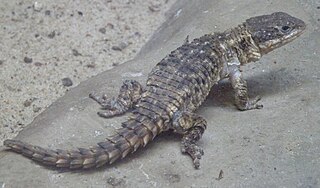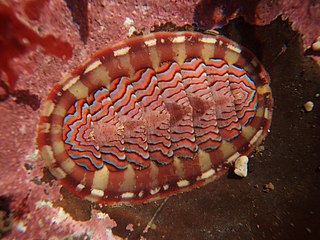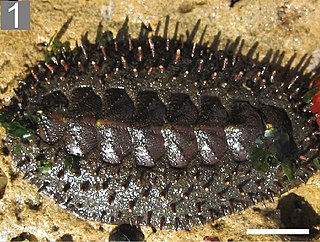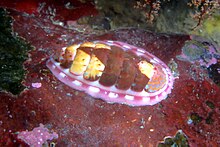
Chitons are marine molluscs of varying size in the class Polyplacophora, formerly known as Amphineura. About 940 extant and 430 fossil species are recognized.

The gumboot chiton, also known as the giant western fiery chiton or giant Pacific chiton, is the largest of the chitons, growing to 36 cm (14 in) and capable of reaching a weight of more than 2 kg (4.4 lb). It is found along the shores of the northern Pacific Ocean from Central California to Alaska, across the Aleutian Islands to the Kamchatka Peninsula and south to Japan. It inhabits the lower intertidal and subtidal zones of rocky coastlines. The gumboot chiton's appearance has led some tidepoolers to refer to it, fondly, as the "wandering meatloaf". The name "gumboot chiton" seems to derive from a resemblance to part of a rubber Wellington boot or "gum rubber" boot.

Chiton glaucus, common name the green chiton or the blue green chiton, is a species of chiton, a marine polyplacophoran mollusk in the family Chitonidae, the typical chitons. It is the most common chiton species in New Zealand. Chiton glaucus is part of a very primitive group of mollusc with evidence of being present in up to 80 million years of the fossil record.

Cryptoconchus porosus, the butterfly chiton, is a species of chiton, a marine polyplacophoran mollusc in the family Acanthochitonidae.

The Limpopo girdled lizard, also known commonly as Jones's armadillo lizard and Jones's girdled lizard, is a species of lizard in the family Cordylidae. The species is endemic to Southern Africa.
A valve is each articulating part of the shell of a mollusc or another multi-shelled animal such as brachiopods and some crustaceans. Each part is known as a valve or in the case of chitons, a "plate". Members of two classes of molluscs, the Bivalvia (clams) and the Polyplacophora (chitons), have valves.

Ischnochiton maorianus, sometimes called the variable chiton, is a fast moving species of chiton in the family Ischnochitonidae, endemic to the main islands of New Zealand where it is abundant.

Acanthochitona zelandica is a species of chiton in the family Acanthochitonidae, also sometimes known as the hairy, or "tufted," chiton. It probably developed during the mid to late Pleistocene, and is endemic to New Zealand.

Tonicella lineata, commonly known as the lined chiton, is a species of chiton from the North Pacific.

Mopalia spectabilis, commonly known as the red-flecked mopalia, is a species of chiton.

Tonicella lokii, commonly known as the flame lined chiton or Loki's chiton, is a chiton in the lined chiton genus Tonicella.

Mopalia muscosa, the mossy chiton, is a species of chiton, a polyplacophoran, an eight-plated marine mollusk. It is a northeastern Pacific species which occurs from British Columbia, Canada, to Baja California Mexico.

Acanthopleura granulata, common name the West Indian fuzzy chiton, is a medium-sized tropical species of chiton. This type of chiton's activity does not depend on spring-neap oscillations leading to lower locomotion loss. Its morphology is different from usual chitons as it has a fifth valve, which is split into halves.

Acanthochitonidae is a family of marine mollusks belonging to the class Polyplacophora, commonly known as chitons. Species are widely distributed throughout the world's oceans, but are most commonly found in the shallow waters of the Pacific Ocean, from Alaska to Chile.

Mopalia ciliata is a chiton in the genus Mopalia, commonly known as the hairy chiton. It is a medium-sized marine mollusc up to 5.0 cm (2.0 in) in length. It is oval shaped with 8 separate, moderately elevated, overlapping ridged valves on its dorsal surface. Hairy chitons can be found along the coast of North America.

Katharina tunicata is commonly known as the black Katy chiton, black Leather chiton, black chiton, or leather chiton,, is a species of chiton in the family Mopaliidae.

Acanthopleura echinata is a Southeast Pacific species of edible chiton, a marine polyplacophoran mollusc in the family Chitonidae, the typical chitons.

Tonicella insignis, the white-lined chiton, or red chiton, also known as the hidden chiton, belongs to the Tonicellidae family in the class Polyplacophora, and the phylum of Mollusca. Its body length of T. insignis is around 5 cm.

Acanthochitona crinita is a species of marine chiton in the family Acanthochitonidae. It is found on rocky coasts in the northeastern Atlantic Ocean, the North Sea and the Mediterranean Sea.

Tonicella marmorea is a species of chiton, a polyplacophoran mollusc found in the Arctic Ocean and the North Atlantic Ocean. It was first described by the Danish missionary and naturalist Otto Fabricius.

















